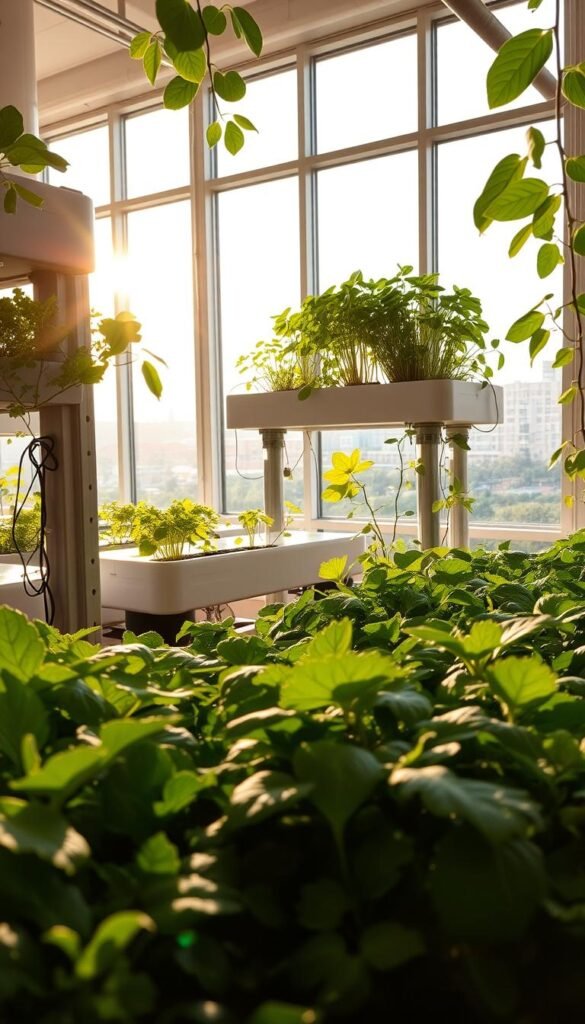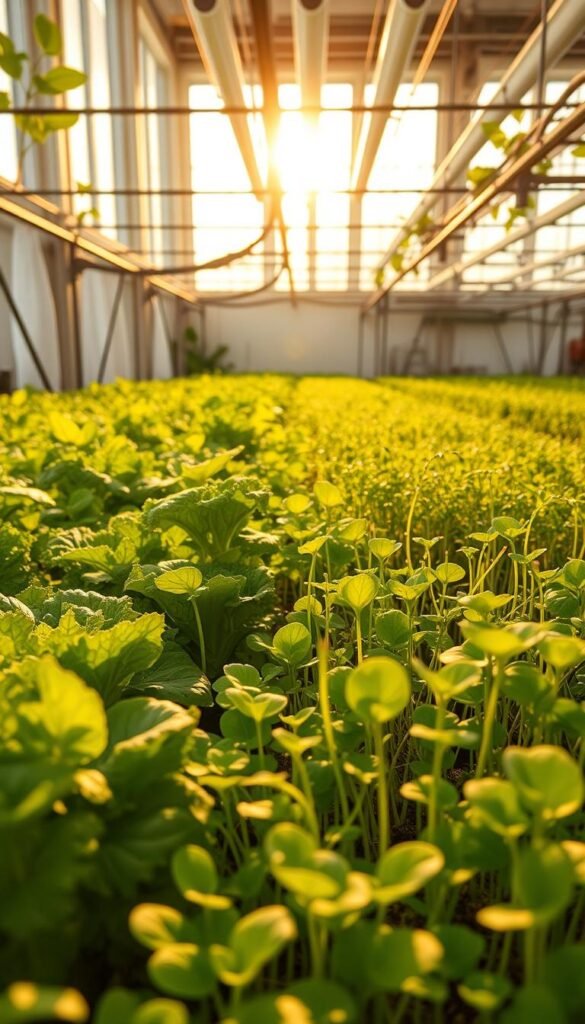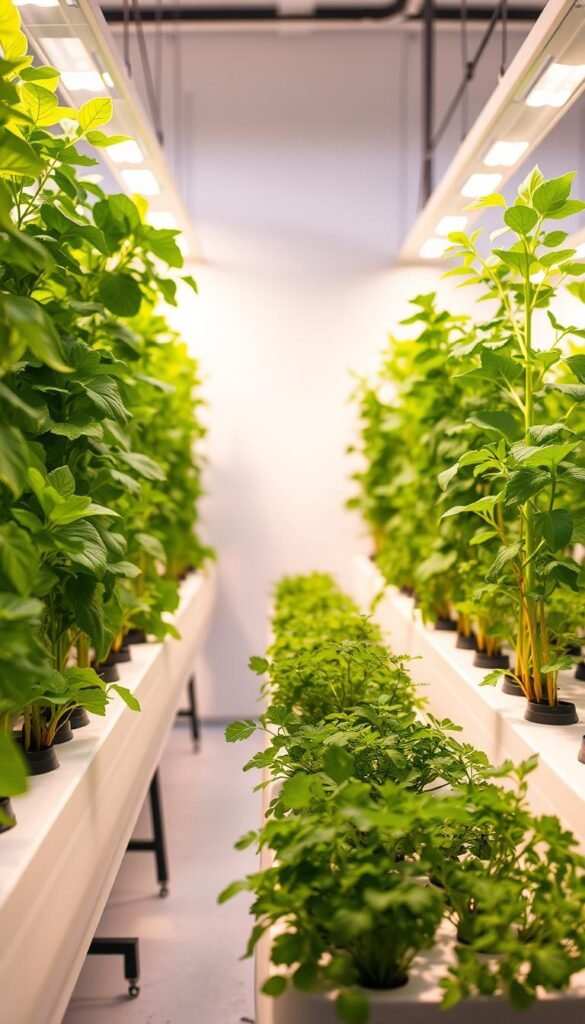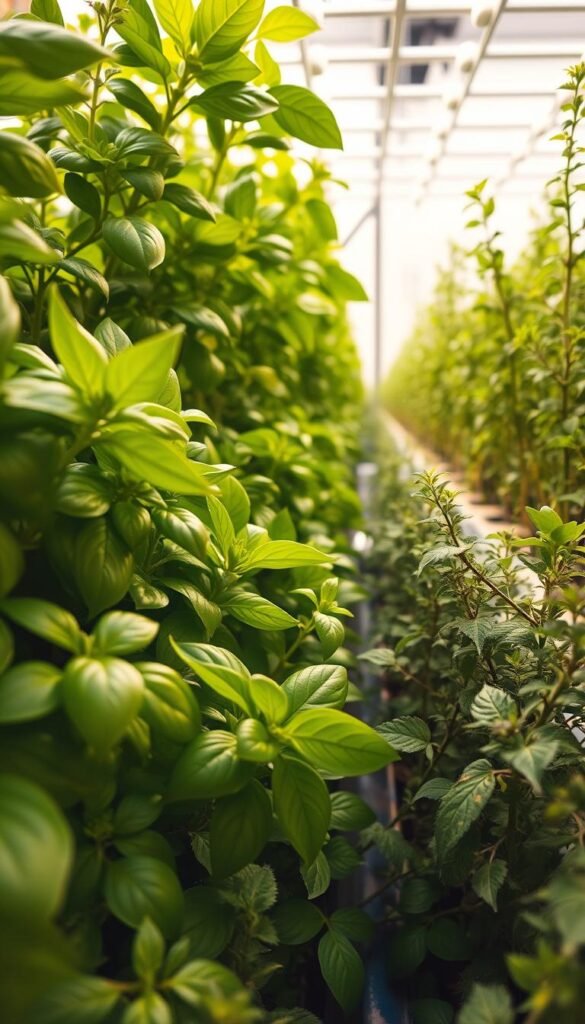Imagine plucking crisp lettuce or fragrant basil from your living room—no backyard required. Hydroponic systems let you grow vibrant, nutrient-rich plants indoors, even in small spaces. With the right setup, you can enjoy harvests up to twice as fast as traditional gardening.
This method skips soil entirely. Instead, plants thrive in water enriched with minerals and oxygen. You control every detail, from light exposure to pH levels, creating ideal conditions for growth. Whether you’re a city dweller or just love fresh herbs, hydroponics turns any room into a productive garden.
We’ll guide you through choosing the best crops for your system. Leafy greens like kale and spinach flourish in these environments, while herbs like mint and oregano add flavor to your meals. Proper plant nutrition and LED grow lights make all the difference—we’ll show you how to balance both.
Key Takeaways
- Hydroponic systems enable faster growth than soil-based gardens
- Leafy greens and herbs adapt particularly well to indoor setups
- Controlled lighting accelerates plant development
- Water-based nutrient delivery boosts plant health
- Compact systems fit easily in apartments or kitchens
Introduction to Hydroponic Gardening for Vegetables and Herbs
Ever wondered how fresh greens thrive without soil? Hydroponic gardening lets you grow lush vegetables and aromatic herbs using nutrient-rich water. This method skips dirt entirely, giving roots direct access to oxygen and minerals. The result? Faster growth and healthier plants compared to traditional methods.

How Water Works Wonders
In these systems, plants sit in water mixed with tailored nutrients. You control everything—pH levels, light cycles, and mineral ratios. This precision means:
- No weeds competing for resources
- Up to 30% faster harvests for leafy greens
- Consistent flavor in herbs like basil and parsley
Indoor Growing, Year-Round Freshness
Your kitchen counter or spare closet can become a mini-farm. Indoor setups let you grow crisp lettuce or peppery arugula even in winter. One gardener shared:
“My thyme and rosemary never tasted better—I harvest every three weeks!”
You’ll gain hands-on experience adjusting grow lights and monitoring solutions. It’s easier than it sounds—most systems include timers and pH test strips. Start small, and soon you’ll enjoy salads and seasonings grown steps from your stove.
Why Choose Hydroponics for Growing Your Garden
What if your plants could grow faster while using less space? Hydroponic systems solve both challenges at once. By removing soil from the equation, roots absorb nutrients directly from enriched water. This creates a supercharged growing environment where crops develop 30-50% quicker than in dirt.

Rapid Growth and Efficient Use of Space
Vertical setups let you stack plants upward, tripling your harvest in tight areas. Kale thrives here—its sturdy leaves reach full size in just 5 weeks. You’ll see results fast because:
- Roots don’t waste energy searching for food
- Tailored mineral mixes prevent deficiencies
- LED lights run 14 hours daily for nonstop photosynthesis
Optimizing Nutrient Delivery and Lighting
Precision is key. Automated pumps circulate fresh solutions hourly, while timers maintain perfect light cycles. Compare hydroponics to traditional methods:
| Factor | Hydroponics | Soil Gardening |
|---|---|---|
| Growth Speed | 3-4 weeks faster | Standard rate |
| Space Needed | 2 sq ft per plant | 4 sq ft per plant |
| Nutrient Control | Exact measurements | Guesswork |
| Year-Round Yield | Consistent | Seasonal |
This controlled environment means fewer pests and diseases. Your basil won’t bolt from heat stress, and mint stays bushier longer. Whether you’re raising microgreens or cherry tomatoes, every plant gets what it needs to grow well.
Top Vegetables and Herbs for a Successful Hydroponic Setup
Growing your own food indoors doesn’t require a green thumb—just smart choices. Certain plants adapt effortlessly to water-based systems, delivering bold flavors and vibrant leaves for your favorite meals. Let’s explore varieties that turn your space into a productive mini-farm.

Overview of Easy-to-Grow Plants
Start with these low-effort superstars:
- Butterhead lettuce: Forms tender cups perfect for wraps—harvest outer leaves weekly
- Genovese basil: Adds aromatic depth to pasta sauces and pesto
- Curly parsley: Brightens soups and grain bowls with fresh, peppery notes
These picks thrive in consistent conditions. Butterhead varieties mature in 25 days, while basil develops bushy stems under LED lights. One gardener noted:
“My parsley stays lush year-round—it’s like having a spice rack that grows itself!”
Incorporate spinach or kale for nutrient-packed salads. Their rapid growth means you’ll trim leaves every 10-14 days. Dill and cilantro also excel, elevating fish tacos or homemade salsas with zesty freshness.
Every plant serves dual purposes. Basil deters pests naturally, and lettuce roots help filter water. You’ll enjoy farm-to-table convenience while mastering indoor farming basics. Soon, your kitchen will overflow with ingredients for vibrant dishes—no grocery run needed.
Best Herbs for Hydroponic Systems
Want restaurant-quality flavor without stepping outside? Your hydroponic garden can become a living spice cabinet. Three aromatic stars rise above the rest for indoor growing success.

Fresh Flavors: Basil, Oregano, and Mint Variants
Genovese basil leads the pack with its large, fragrant leaves—perfect for caprese salads or homemade pesto. Oregano follows closely, offering earthy notes that elevate pizza sauces and roasted veggies. Both herbs pack antioxidants like rosmarinic acid, giving your meals a nutritional boost alongside bold tastes.
Try these growth champions:
- Sweet basil varieties (6-8 hours of daily light)
- Greek oregano (thrives in slightly alkaline water)
- Peppermint (keep roots cool below 75°F)
One urban gardener shared:
“Starting with nursery cuttings cut my harvest time in half—I’m making mint mojitos weekly!”
Care Tips for Consistent Growth
Keep your herbs productive with three simple rules. First, maintain water pH between 5.5-6.5 using test strips. Second, prune stems regularly to encourage bushier growth. Third, rotate plants under LED lights every 3 days for even exposure.
| Herb | Ideal pH | Light Hours | Harvest Time |
|---|---|---|---|
| Basil | 5.8-6.2 | 14 | 3-4 weeks |
| Oregano | 6.0-6.5 | 12 | 5-6 weeks |
Experiment with purple basil or golden oregano for visual flair. Your morning omelet will thank you—and your hydroponic setup will prove dirt-free gardening delivers superior flavor every time.
Best Vegetables for Hydroponic Systems
Your kitchen could become a salad bar that never closes. Hydroponic setups excel at producing both fast-growing leafy greens and robust fruiting vegetables. Choose varieties that match your space and taste—whether you crave daily salads or homemade salsa.
Lettuces, Kale, and Salad Greens for Quick Harvests
Snip fresh leaves every 10 days with these rapid growers:
- Romaine lettuce: Crisp ribs perfect for wraps—harvest outer leaves first
- Baby spinach: Tender leaves ready in 3 weeks—ideal for smoothies
- Red Russian kale: Colorful stems add texture to stir-fries
One urban gardener reported:
“I harvest butterhead lettuce twice weekly—my sandwiches never tasted better!”
| Vegetable | Days to Harvest | Yield per Plant |
|---|---|---|
| Buttercrunch lettuce | 25 | 8-10 cups |
| Curly kale | 35 | 1 lb |
| Spinach | 21 | 6-8 oz |
Hearty Options: Tomatoes, Peppers, and Cucumbers
These sun-lovers need 14+ hours of daily light but reward you with juicy yields. Cherry tomatoes thrive in vertical systems—their compact vines produce clusters of sweet fruits. Bell peppers develop thicker walls under LED grow lights compared to outdoor crops.
| Vegetable | Light Needs | Support Required |
|---|---|---|
| Tomatoes | 16 hours | Trellis netting |
| Peppers | 14 hours | Stakes |
| Cucumbers | 14 hours | Vertical frame |
Keep roots warm (70-75°F) for peppers, and maintain pH at 5.8-6.3 for tomatoes. With proper care, you’ll enjoy plump tomatoes and crunchy cucumbers even in apartment settings.
Optimizing Your Hydroponic Environment
Your plants’ performance hinges on three factors: pH balance, light intensity, and nutrient ratios. Master these elements, and you’ll unlock consistent harvests with minimal effort. Let’s break down how to maintain this delicate equilibrium.

Maintaining the Ideal pH (5.5 – 6.5)
Plants absorb nutrients best when water stays between 5.5 and 6.5. Outside this range, roots struggle to uptake minerals—even if they’re present. Test weekly with digital meters or test strips:
- Adjust acidic solutions (below 5.5) with potassium hydroxide
- Lower alkaline levels (above 6.5) using phosphoric acid
- Record readings to spot trends over time
| Plant Type | Optimal pH Range |
|---|---|
| Leafy Greens | 5.5 – 6.0 |
| Herbs | 6.0 – 6.5 |
| Fruiting Plants | 5.8 – 6.3 |
One grower shared their routine:
“I check pH every Monday—it takes 2 minutes and prevents nutrient lockout.”
Importance of Light and Nutrient Management
LED grow lights should run 12-16 hours daily, depending on crop type. Use timers to mimic natural cycles. Pair this with balanced nutrients:
- Nitrogen-heavy mixes for leafy growth
- Potassium boosts during flowering stages
- Calcium supplements to prevent tip burn
Rotate plants weekly for even light distribution. Combine these practices with your 5.5-6.5 pH maintenance, and you’ll see healthier roots and faster maturation. Your system becomes a self-sustaining engine of growth.
Advanced Tips and Maintenance for Your Hydroponic Garden
Ready to take your indoor growing skills to the next level? Even well-established hydroponic systems need fine-tuning as your garden matures. Let’s explore strategies to keep roots thriving and yields climbing.
Troubleshooting Common Growing Issues
Spot problems early by checking roots weekly. Healthy ones appear white and fuzzy, while brown or slimy roots signal trouble. For persistent issues:
- Flush systems with pH-balanced water if mineral buildup occurs
- Introduce beneficial bacteria to combat root rot
- Adjust EC levels (1.2-2.4) based on plant growth stages
| Symptom | Likely Cause | Quick Fix |
|---|---|---|
| Yellow leaves | Nitrogen deficiency | Increase nutrient solution strength |
| Stunted growth | Low oxygen | Add air stones or adjust water flow |
| Leaf curling | pH imbalance | Test and adjust to 5.8-6.3 |
Seasonal Adjustments and Upgrading Systems
Winter brings drier air—boost humidity with pebble trays. Summer heat? Add chillers to keep water below 75°F. When expanding your setup:
- Rotate crops like mustard greens to prevent nutrient depletion
- Upgrade to modular systems for easier scaling
- Install backup power for pumps during outages
One grower upgraded their hydroponic cultivation with smart sensors:
“Automated pH alerts cut my maintenance time by half!”
| Season | Light Hours | Temp Range |
|---|---|---|
| Winter | 14-16 | 68-72°F |
| Summer | 12-14 | 70-75°F |
Incorporate peppery mustard greens—they’re perfectly suited hydroponic plants that thrive in cooler water. Regular system audits and crop rotation will keep your garden productive through every season.
Conclusion
Transform your kitchen into a fresh produce hub that defies seasons. With a hydroponic system, you’ll harvest crisp greens and aromatic herbs regardless of outdoor weather. Imagine snipping basil for Friday-night pizza or plucking strawberries for morning smoothies—all from your countertop garden.
Selecting the right plants ensures success. Leafy greens like spinach thrive in water-based setups, while herbs such as oregano add bold flavors to meals. For variety, try strawberries—their sweet yields work beautifully in vertical systems. Discover more best herbs for hydroponic systems to expand your indoor farm.
Consistent care delivers rewards. Monitor pH levels, adjust lighting schedules, and watch your food grow faster than soil-based methods. One gardener shared: “My year-round salads taste better—and I’ve saved hundreds on groceries!”
Start small. A simple setup lets you learn while enjoying weekly harvests. Soon, you’ll relish the pride of serving home-grown dishes every month. Ready to taste the difference? Your hydroponic journey begins with a single seed—and ends with endless freshness.






